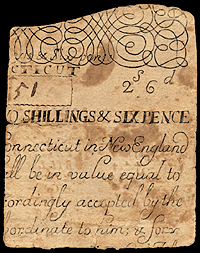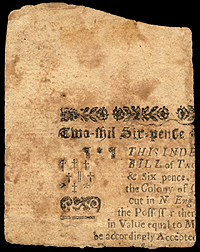An emission of £2,000 in indented legal tender bills of credit authorized by acts in October and November, 1724 for the exchange of worn notes. The first emission of Connecticut notes was issued on July 12, 1709 from plates engraved in Boston by Jeremiah Dummer (an apprentice of John Hull). The plates were used to print an additional emission with a red AR monogram added to the front of the note and then for an emission redated May 1713 that was issued in two varieties, one had scrollwork on the top bordet of the back and the other has a flower pattern. The next issue was the emission of December 1, 1724, which used the face plates as found on the May 1713 emission but included typeset backs. This was the first Connecticut issue to contain printing on the back. Printed in New London by Timothy Green. The front of each note has scrollwork at the top indent, below the engraved text is the seal of the colony with three grape vines with the motto "SUSTINET QUI TRANSTULIT" (What is transplanted survives). Denominations in this issue were: 2s, 2s6d, 3s, 5s, 10s, 20s, 40s and £5.
 rev
rev
Size: indented upper right quarter of the obverse 68 x 53mm.
Comments: This 2s6d note was torn into quarters to make small change, each quarter being 7 and 1/2d. Much of the text and the signatures are missing. The text on the front can be reconstructed from surviving notes of earlier emissions. The text would have read: THIS INDENTED BILL OF TWO SHILLINGS & SIXPENCE / Due from the Colony of Connecticut in New England / to ye Possessor thereof shall be in value equal to / Money : And shall be accordingly accepted by the / Treasurer & Receivers subordinate to him; & for / any stock at any time in ye Treasury Hartford July / the twelfth Anno Dom: 1709. By Order of ye General Court/ [redated below as] May 1713. The typeset text on the reverse is similar but there is no complete example known (earlier emission had no text on the back).
This quarter section is the Newman plate. According to the Smythe catalog entry receipt of broken notes was prohibited in 1727 but the practice continued long thereafter. Also it is inferred there are no surviving notes in better condition.
Provenance: Purchased through the Robert H. Gore, Jr. Numismatic Endowment from the R.M. Smythe Chicago Paper Money auction of February 17, 2000, lot 1005.